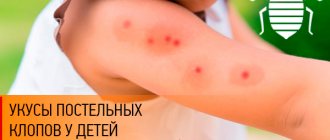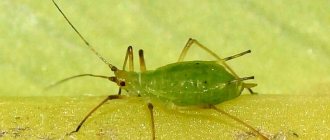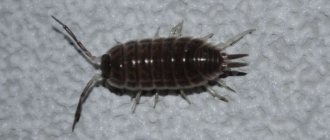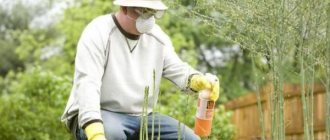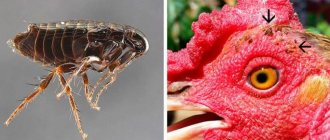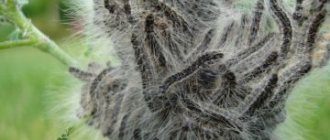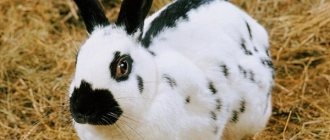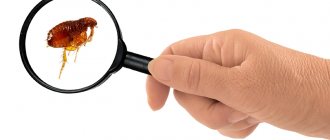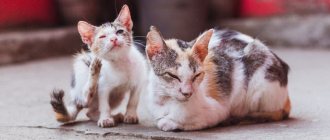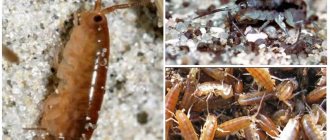Fleas, ectoparasites of mammals, can live on rabbits as well as on cats and dogs. Rabbit fleas move freely in the hair and try not to leave the owner. For the host, insects are dangerous as carriers of infectious diseases and helminths.
- Flea remedies
- Drops of Stronghold
- Advocate
- Advantage
- Advantix
- Acaromectin
Drops
Flea drops for rabbits must be chosen carefully. Products that can remove insects from dogs and cats are not suitable for rabbits. Preparations containing the active ingredient fipronil are lethal for these animals. The popular insecticide Frontline should never be used on rabbits.
All drops are applied equally. The ampoule is poured onto dry skin, spreading the hair at the withers. The rabbit will not be able to reach there to lick the drug. Bathing the rabbit, stroking the treatment area and allowing children near the animal is prohibited for 2 hours after applying the product.
Any insectoacaricidal drug is toxic; exceeding the dosage can lead to poisoning of the animal.
To treat an infected pet, drop treatment is used once. To prevent secondary infestations - once a month during the season of activity of blood-sucking insects.
A contraindication is an allergic reaction or hypersensitivity to one of the components of the drug.
Stronghold
The active ingredient of the drug is selamectin. The dosage is calculated based on the weight of the animal. The solution is produced in 6% and 12%, the pipette contains a volume from 0.25 ml to 2 ml. For an animal weighing 2.5 kg, the instructions recommend 0.25 ml of a 6% solution. It is better to take the packaging for kittens and calculate the dosage according to the instructions.
Stronghold is a broad-spectrum insecticide that is effective against flea, ear and scabies bites. It has anthelmintic properties, destroys nematodes (ascaris and toxocar). Selamectin not only causes the death of adult insects, but also interrupts their development cycle.
The instructions indicate that there are no side effects of selamectin for pregnant and lactating female cats and dogs. The use of the drug for pregnant and lactating rabbits, as well as baby rabbits, has not been thoroughly studied.
Advocate
The German-made Advocate product contains imidacloprid, a nerve agent insecticide. Effective against fleas, ticks, lice and other parasites. Preferably packaged in 0.4 ml pipettes for cats weighing up to 4 kg and ferrets. One bottle is the standard dose of medicine for a decorative rabbit.
Ampoules are not used if the animal weighs less than a kilogram.
Advantage
Bayer's Advantage for kittens and cats up to 4 kg is available in a dosage of 0.4 ml. The active ingredient imidacloprid is effective against ectoparasites. The medicine lasts for a month.
Advantix
Advantix - an analogue of the previous medication contains imidacloprid and permethrin. Dosage is calculated by weight: 0.1 ml per kg. If several rabbits are being treated at the same time, they should be spaced out so that the animals do not lick each other.
The drug is absorbed into the blood within 4 hours. Not suitable for sick rabbits, as well as pregnant and lactating females.
Appearance of an insect
Not everyone knows what a flea on a decorative rabbit looks like. All blood-sucking parasites have a similar anatomy. They have a body elongated in length and compressed at the sides.
It is covered with plates on top. It has 6 legs, each of which has bristles that allow the parasite to cling to the rabbit's fur.
Pests are well camouflaged in the thick fur of pets. You can tell that a rabbit has fleas by the fact that the animal begins to actively itch.
Blood clots are visualized on the skin, and as the animal itches, black or brown parasites fall from its body.
Sprays
Treatment of parasitic infestations can be carried out using sprays. Shake the bottle thoroughly and spray the pet against the grain from a distance of 10 cm. You should move from the tail to the head, protecting the eyes and ears from the spray.
Allow the animal to dry as usual without disturbing the fur, and comb it thoroughly with a fine-toothed comb. After the procedure, the rabbits' fleas die.
Spray the cage from a distance of half a meter and get rid of the contaminated bedding.
The rabbit should be re-sprayed against bites after 30 days or after bathing.
The drugs are combined with other antiparasitic drugs if they are used at intervals of 2-3 days. The spray is not suitable for pregnant and lactating rabbits.
Acaromectin
A solution for external use based on ivermectin, a nerve agent insecticide. Used against lice, lice and fleas. The drug is low-toxic, applied in small doses to the ears, back of the head, neck and back.
Beaphar Immo Shield Spray
Suitable for pets - cats, dogs, rodents and rabbits, as well as for disinsection of their habitats. The main active substance dimethicone acts on the respiratory system of fleas. To relieve itching, the spray contains aloe vera extract, which has a wound healing and antibacterial effect.
Collars
This is not a good flea treatment for rabbits. The tape is impregnated with dangerous drugs that have a toxic effect on the animal. The collar is not suitable for young animals; the animal may be poisoned or injured. Anti-parasitic tape is worn when walking to prevent infection and removed upon returning home.
Bars and Dana Ultra products containing fipronil are strictly prohibited. Rabbit breeders are inclined towards the German brand Bolfo (Bolfo) based on propoxur.
Preventive measures
The best treatment is to use flea preventative measures. To prevent the appearance and spread of bloodsuckers not only in the rabbit, but throughout the house, the following measures are recommended: • Regular cleaning will help create unfavorable conditions for the appearance and reproduction of fleas: clean the rabbit's cage as often as possible and change the bedding. • The animal must be periodically checked and its coat cared for. • You should also make sure there are no fleas in your home with other pets. • Cleaning the entire room is equally important! Your rabbit will not get fleas if you follow these guidelines, so you can avoid the hassle and problems associated with it. Prevention is perhaps the easiest way to monitor your pet's health.
Let's not forget that we are responsible for those we tame. If you find fleas, don’t just exterminate the parasites, treat the entire apartment.
Other means
This includes injection liquids, ointments, shampoos, and powders. Injection solutions are used in large rabbit farms, when funds do not allow purchasing a package of ampoules for each animal.
- Ivertel is a well-known injection solution in animal husbandry based on ivermectin and closantel. Effectively acts against ectoparasites and nematodes of the gastrointestinal tract and lungs. After the injection, the medicine is absorbed into the blood, causing paralysis and death of the parasites that have bitten the animal. The concentration required for a therapeutic effect is maintained for two weeks after injection.
- Neostomazan should be diluted in water and the rabbits should be bathed once a week. Effective against fleas and ticks.
- Bolfo is available in the form of shampoo, spray and powder.
- Butox is a broad-spectrum insectoacaricidal drug. The animal's fur is rubbed with emulsion when washing.
- Aversectin ointment is a universal remedy for external use. It has a pronounced insectoacaricidal effect and is low toxic.
When treating a rabbit with shampoos, the product is applied to the fur, protecting the eyes and ears. Add a little warm water, foam and wait 10-15 minutes. Rinse off the shampoo with warm water and comb the animal thoroughly. Repeated treatment is carried out after a month.
The danger of flea bites
Constant parasite bites weaken the rabbit's immunity. Susceptibility to colds increases several times. In addition, if blood-sucking insects are widespread, the rabbit may become anemic. Fleas are also carriers of worms.
Fleas are carriers of infectious diseases.
Moving from one animal to another, they carry many viruses that can be fatal to rabbits:
- myxomatosis;
- purulent conjunctivitis;
- viral hemorrhagic disease.
The bite site often becomes inflamed, red, and itchy. The animal scratches the wound even harder with its paw, causing infection.
It is also important that when breeding rabbits for the purpose of selling furs, you can incur losses due to the fact that the appearance of the skins will be spoiled as a result of flea infestation.
Considering all the dangers of flea bites, it is necessary to take timely measures. This will get rid of fleas without affecting your pet's health.
How to get rid of flea eggs
Fleas are fully metamorphosed insects that go through three stages of development. The female is not looking for a special place to lay eggs, so parasite eggs will definitely be on the rabbit’s fur, bedding, floor, etc. The egg hatches into a larva after two weeks. After several molts, it pupates and, while in a cocoon, turns into an adult flea.
To destroy eggs and larvae, a rabbit treated with insecticides must be removed from the cage and thoroughly disinfested.
Physical means of disinfection:
- mechanical removal of debris, cleaning of the cage;
- burning metal parts with a blowtorch fire;
- scalding with boiling water or steam at a temperature of 100 degrees.
Of the chemical compounds, 0.5% aqueous emulsion of chlorophos is used to spray the habitat of the animals. In pet stores you can find BEAPHAR Anti-parasite Spray, specially designed for indoor treatment.
conclusions
- Fleas - blood-sucking insects - are not only an unpleasant problem on the hair of rabbits, but also a source of infection for serious diseases.
- The disease is best and most successfully identified at the initial stage, as well as treating ear mites.
- In addition to the procedures for eliminating fleas from a rabbit, it is necessary to disinfect the cage space, bedding and drinking bowls.
- Strictly follow the instructions for dilution , application and concentration of drugs, as they have a high degree of toxicity.
What is the danger of fleas and their eggs for rabbits?
Rabbits are sensitive animals to stress and illness. Flea infestation leads to the following pathologies:
- Myxomatosis. This is a serious viral disease accompanied by purulent conjunctivitis. A sick rabbit develops tumors in the head, anus and genital areas. Domestic and ornamental animals are sensitive to the pathogen carried by rabbit fleas. Parasites inject the virus into the rabbit's blood when they bite. As a preventive measure, pets are vaccinated, since treating myxomatosis is ineffective.
- Helminthiasis. Fleas are temporary hosts of some types of helminths. If a rabbit bites an insect, the parasite larva will enter the body, causing helminthic infestation.
- Anemia. Develops in advanced cases due to large blood loss.
From constant bites, the animal experiences severe itching, causing scratching and skin irritation. The animal loses appetite, sleep, becomes irritated and nervous.
General information
Do rabbits have fleas? Yes, two types of parasitic blood-sucking insects can live in the thick fur of these animals. The first type affects all domestic animals, the second can only be found in rabbits. But both varieties carry dangerous diseases.
It is impossible to understand that a rabbit has fleas without a careful examination. The parasites are camouflaged in thick fur, and people become aware of them when the animals begin to itch intensely, clots of dried blood appear on their skin, and while combing, black or brown insects up to 0.5 cm long fall out. bite site, in the later stages it bites itself. An alarmed pet is a reason to contact a veterinary clinic, where they will make a diagnosis and select an effective medicine.
A pet can become infected through contact with sick animals, while walking outside, through equipment or furniture in which flea eggs live. These parasites cover distances of up to a meter in a jump and settle in fur coats, carpets, rugs and other fleecy surfaces.
Treatment with traditional methods
These methods are good as additional measures to the main antiparasitic therapy. Folk remedies are not able to destroy insects and cure an already infected animal.
The following methods are traditionally used:
- The animal is rubbed with an infusion of herbs that repel fleas - wormwood, celandine, tansy, eucalyptus.
- The cages are covered with pine sawdust, and fresh fir branches are laid out.
- The rabbit is bathed in a salt solution (2-3 tablespoons of salt per liter of water). The pet is dipped, being careful not to get its head wet, and kept for 10 minutes. Rinse, dry naturally and comb out dead insects.
- Bundles of wormwood or tansy are laid out in the rabbitry. Fleas have a good sense of smell; the pungent aroma of herbs overpowers the smell of food.
Prevention of infection with blood-sucking parasites is the care of rabbit fur. The pet is regularly examined and combed with a fine comb. The cells are kept clean and efforts are made to prevent contact with possible carriers of parasites.
Symptoms of infection
The flea is small in size and its body is dark brown or black. Therefore, it is difficult to find an insect in a rabbit's fur.
To determine whether an animal has fleas, you need to sit it on your lap and examine the places where parasites are most concentrated: in the area of the ears and withers.
Symptoms of infection are:
- skin lesions in the form of red dots and bruises;
- signs of itching in the animal (the rabbit is actively itching);
- decreased appetite;
- a manifestation of the animal's dissatisfaction when it is picked up.
If there are no signs of infestation, but the presence of fleas remains suspected, you can use the following method:
- Place a white sheet of paper.
- Place an animal on it.
- Comb your rabbit with a fine-toothed comb. If the animal is infested, flea larvae and eggs will be visible on the paper.
What diseases cause
Fleas infect Eared Ears in the area of the withers or spine. The greatest danger is caused by diseases such as VGBK, purulent conjunctivitis and myxomatosis.
Myxomatosis
This is a dangerous viral disease that can be fatal if you do not promptly seek treatment from a veterinarian. The disease is spread by blood-sucking insects (for example, through a flea or mosquito bite) or from a sick individual to a healthy one (sexually or by airborne droplets).
The disease is manifested by the following symptoms:
- redness of the mucous membrane of the eyes;
- decreased activity in the animal;
- lack of appetite;
- redness around the eyes;
- nodular formations on the head, ears and around the eyes (at a later stage of the disease they appear on other parts of the body);
- temperature rise to +40–41 °C;
- swelling of the head, back and genitals.
Important! The myxomatosis virus can exist on a dead carcass for up to 2 weeks. To neutralize it, dead animals must be burned.
An accurate diagnosis can only be made by a veterinarian who, during the examination, takes biomaterial for testing. For this purpose, the affected areas of the skin are used.
VGBK
Rabbit viral hemorrhagic disease (RVHD) is a dangerous disease that very quickly affects the entire body of the animal. If not detected and treated in a timely manner, the virus can lead to death not only of the sick individual, but also of the entire brood.
The disease has 2 different forms: acute and chronic. The second manifests itself due to improper care of animals during feeding, and acute - as a result of contact with a sick individual or during transportation, contact with cattle.
Familiarize yourself with the diseases of rabbits, methods of their treatment and prevention.
The virus can live for a month in manure or up to 3 months in the carcass of a dead rabbit.
Symptoms of the acute form of the disease:
Checking your rabbit regularly
In order to prevent excessive reproduction of fleas, you need to notice the disease at an early stage. To do this, you need to examine your pet at least once a month. This procedure is carried out using a fine-toothed comb. The rabbit is placed on a sheet of paper or a white towel and begins to be combed against the grain. Against a white background, black insects, their yellowish-white eggs and dark balls of excrement will be clearly visible.
Of course, in large rabbit farms it is impossible to constantly inspect all animals. In this case, it is necessary to carry out preventive measures and send newly purchased individuals to a month-long quarantine.
Causes of parasites
A rabbit, like any animal, is capable of picking up parasites from outside. The larvae of these insects are found in the pus of rabbits (especially dry). To prevent infestation, it is necessary to regularly clean kennels and cages.
Fleas living on eared animals do not have a specific physiology located specifically for these animals. These are common fleas that can infect dogs, rats and cats, so even short contact with an infected individual can lead to infection.
Signs
The oral apparatus of fleas is of the piercing-sucking type. Rabbits are bothered by bites and itching. Comparison of the signs of flea bites in a rabbit and the gnawing of the skin of rabbits by tick mites:
- superficial rash (papule) - flea bite and (pustule) - itch mite;
- superficial abrasions (flea), deep skin damage (ticks);
- rabbits of long-haired breeds show a tendency to mat their fur (fleas);
- baldness in areas accessible to the rabbit for combing (usually ticks, sometimes fleas);
- exhaustion and death of rabbits from fleas in modern rabbit farming practically does not occur, but it can happen due to parasitism by tick mites.
Processing of cells and equipment
Cages for outdoor rabbits, burn equipment with a blowtorch (in winter), and rinse in summer with alkaline solutions. Wash cages of decorative rabbits with plastic elements with any household cleaner and dry. Place carpets, mats, etc. in the cold (in winter) for several hours, in the summer in the sun and pat them. Sprinkle the floor in the rabbitry, especially the cracks, with slaked lime or a desiccant of the finest fraction. Keep rabbits away from dusty desiccant. Vacuum the floor in the apartment thoroughly, especially in corners and crevices. Wash with one of the household products.
Prevention
To prevent flea infection, contact between healthy animals and infected animals is excluded.
For farm rabbits, it is necessary to regularly clean the cage and change the bedding in it, and carry out preventive disinfestation of the premises.
When a decorative rabbit lives in a house or apartment, you need to periodically vacuum the carpets and clean the house more often. Favorite places for fleas are carpets, cracks in the floor and walls. Basements, upholstered furniture
Domestic cats and dogs wear anti-flea collars for prevention. For rabbits, the drugs used in collars are excessively toxic, so collars are contraindicated for them. If you wear it, then only for a short time, for a walk in the yard, where there is a risk of picking up fleas.

